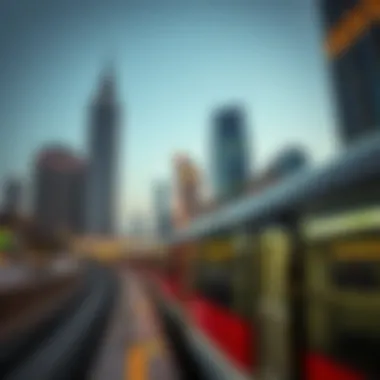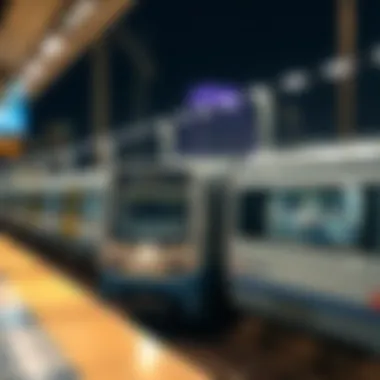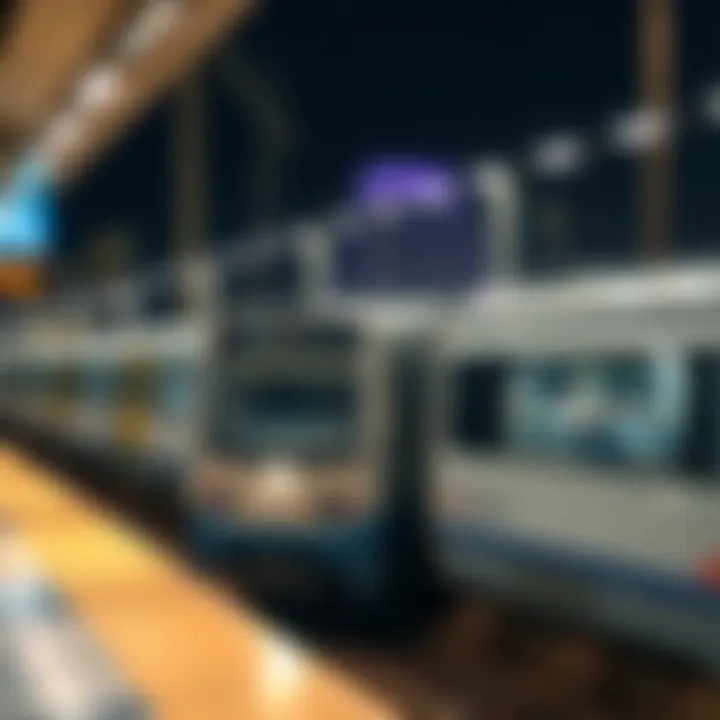Comprehensive Guide to Dubai Metro Timings and Travel


Intro
Navigating a bustling city like Dubai can be both thrilling and daunting, especially when it comes to understanding its public transportation system. The Emirates boasts one of the most efficient metro systems in the world, connecting the most important areas of the city. Understanding the metro timings is crucial not only for daily commuters but also for those visiting the city for the first time or establishing a life in this desert metropolis.
Every metro line and station has its unique appeal, but missing a train or getting stuck during peak hours can turn a simple journey into a frustrating ordeal. Hence, grasping the ins and outs of metro timings—such as operational hours, peak and off-peak schedules, and how they intersect with local events—is essential for making the most of your travels around Dubai. This guide aims to shed light on these nuances, providing valuable insights that will make your daily commute or tourist trips a breeze.
In this section, we will delve into the operational hours of the metro, discuss how to read the schedules effectively, and explore various factors influencing travel patterns throughout the week. Knowing these details can help you dodge the crowds and enjoy a smoother experience as you explore this vibrant city.
Preamble to Dubai's Metro System
Dubai's Metro system stands as a testament to the city’s ambitious urban planning and commitment to modernity. As one of the most advanced public transport systems in the region, it serves both residents and visitors in navigating one of the world's fastest-growing cities. Understanding the subtleties of the Metro's operational timings is crucial for making the most out of what it offers. This guide delves deeply into these timings, ensuring that users can plan their journeys with confidence.
Historical Context
The inception of the Metro system in Dubai dates back to the late 1990s, driven by a need to alleviate the challenges posed by rapid urbanization. The project was initiated in response to burgeoning traffic congestions due to a sharp increase in population and car ownership. The first line, known as the Red Line, opened to the public in 2009, marking a significant milestone in public transit. Over the years, the system has expanded, now encompassing two primary lines, several extensions, and a plethora of connected stations.
The development process was not without its hurdles. Engineers faced extreme weather conditions and logistical challenges while rolling out such a comprehensive infrastructure. Nevertheless, the successful launch was celebrated as a leap towards sustainable urban transport, reflecting the broader economic visions set forth by the city’s leadership.
Importance of Metro in Urban Mobility
The Metro is more than just a mode of transport; it's a crucial component of Dubai's transport network. It dramatically reduces travel time compared to traditional road transport, offering swift connectivity across major urban areas. This efficiency is particularly beneficial in a city where traffic snarls can be as common as sandstorms.
Moreover, the Metro system fosters inclusivity within urban mobility, providing affordable transportation options to diverse demographics including expatriates, families, and tourists. With stations strategically placed near key landmarks such as the Dubai Mall, Burj Khalifa, and business districts, it plays a vital role in facilitating access, thus contributing to local economic activity.
It’s worth noting that an understanding of the Metro system's timings and structure is essential for effective navigation. Knowing when to ride or avoid peak hours can save time, enhance convenience, and allow for smoother journeys across this bustling city.
Operational Hours of Metro Services
The operational hours of the metro services in Dubai hold significant importance, especially for those who rely on this rapid transit system for commuting. Understanding these timings can make or break your travel experience in this bustling city. With the metro being one of the most efficient ways to navigate Dubai's sprawling landscape, knowing when trains run ensures that you can plan your journey effectively.
In this section, we will dissect the different aspects of metro operational hours, touching upon regular service hours, weekend and holiday timings, and provisions for early morning and late-night services. This deep dive aims to equip you with knowledge that enhances your efficiency while using the metro, no matter if you're an expat, tourist, or local resident.
Regular Service Hours
Dubai's metro system operates primarily from 5:00 AM to midnight on weekdays, though this may vary slightly depending on the specific line or station. The Red and Green lines, which are the two primary lines, have the same operational time, thus offering consistency for commuters. It’s crucial to note that the trains run every 2-5 minutes during peak hours, which generally span from 7:00 AM to 9:00 AM and 5:00 PM to 7:00 PM. Understanding these peak timings helps travelers avoid the unwanted hustle and bustle during rush hours.
Tip: If you can, try to travel during non-peak times for a more leisurely experience.
Each station is well marked, with boards displaying real-time train schedules, enabling travelers to plan their journeys with greater accuracy. As an illustration, if you’re heading from Burj Khalifa/Dubai Mall station to Deira City Centre, with trains arriving at even intervals, you can typically expect to reach your destination in about 20-30 minutes depending on transfers. This is particularly beneficial for investors and business people who have tight schedules to adhere to.
Weekend and Holiday Timings
Weekends in Dubai generally see an uptick in leisure activities, leading to extended metro hours. On Fridays and Saturdays, the metro operates from 10:00 AM to 1:00 AM, allowing night owls and social butterflies to enjoy Dubai's vibrant nightlife without worrying about getting home. This change in hours caters well to families and groups looking to explore shopping centers and entertainment hubs.
Public holidays can lead to further adjustments; for example, during important national celebrations or festivals, the metro may operate on special hours to accommodate the influx of commuters. Knowing these timings is essential for those planning outings or events during significant occasions.
Early Morning and Late-Night Services
For the early risers, it's worth noting that the Dubai Metro offers a convenient service that begins at 5:00 AM during weekdays. However, not all stations see foot traffic at these hours, meaning the service is tailored for the working crowd and those heading to early flights from Dubai International Airport.
Late-night services, particularly on weekends, can be a game changer for social events or late-night dining. With trains operating until 1:00 AM on weekends, individuals can venture out with peace of mind, knowing they have a reliable way to return home. This feature is vital for tourists exploring local nightlife and helps improve satisfaction among expatriates seeking to integrate into communal activities.
In summary, understanding the operational hours profoundly enhances the overall experience of using the Dubai metro. It offers not just convenience but peace of mind, allowing commutes to be planned with ease. Whether you are a visitor, investor, or local resident, being in the know about metro timings is an invaluable asset in this dynamic city.
Frequency of Metro Trains


The frequency of metro trains is a crucial element in navigating through Dubai's vibrant urban landscape. Understanding how often trains run not only saves time but enhances the overall travel experience. It ensures that passengers can plan their journeys efficiently, making it easier to coordinate appointments, meetings, or leisure activities. For those new to the city or simply visiting, a grasp of the metro's frequency helps to avoid the frustration of long waits or unexpected delays.
Peak Hours Frequency
During peak hours, which typically span from 7:00 AM to 9:00 AM and again from 5:00 PM to 8:00 PM on weekdays, the frequency of metro trains takes on heightened importance. At these times, trains are scheduled to arrive every two to five minutes. This swift service is designed to accommodate the bustling crowds of commuters heading to work or school, thus alleviating congestion on the roads and providing a predictable and reliable means of transport.
For example, if you're heading from the bustling Dubai Marina to the city’s central business districts, knowing that trains come frequently allows you to jump onto one without much delay. It means that you can plan your departure with an understanding that the metro will be waiting for you at regular intervals. It’s a lifeline for those who are conscious of time and prefer to avoid the unpredictability of road traffic.
Off-Peak Hours Frequency
Contrastingly, during off-peak hours, which include mid-mornings and early afternoons, the frequency of trains generally reduces. Trains may arrive every seven to ten minutes during these quieter periods. This adjustment in schedule is reflective of the lower passenger volumes, offering a calmer travel experience.
This can be particularly beneficial for tourists wishing to explore the city comfortably, without the throngs of commuters. For those looking to maximize their time visiting landmarks like the Burj Khalifa or the Dubai Mall, knowing the quieter train times means less stress and more opportunity to enjoy the sights.
*In short, familiarizing oneself with the frequency of metro trains, both during peak and off-peak hours, empowers passengers to navigate their journeys with confidence, ensuring they arrive at their destinations on time without unnecessary hassle.*
Understanding these aspects of train frequency not only enriches the journey but also aligns with Dubai’s vision for a seamless transit experience.
Ultimately, whether you're a local resident or a transient visitor, having insight into when to catch the metro can eliminate travel uncertainties and enhance your Dubai experience.
Factors Influencing Metro Timings
Navigating through Dubai's bustling urban landscape often hinges on the efficiency of its metro system. The timing of metro services is not static; it fluctuates based on various external elements that can influence the ease or complexity of daily commutes. Understanding these factors becomes key, especially for investors, expatriates, and even tourists who rely heavily on public transportation. This section aims to shed light on aspects that contribute to shifting metro schedules, helping patrons plan more effectively.
Impact of Special Events
Dubai is known for its array of special events, drawing crowds from near and far. Whether it’s the grandeur of the Dubai Shopping Festival or significant international exhibitions like Expo 2020, these gatherings can cause considerable changes to metro timings. On such days, local and foreign visitors alike might find the metro running at extended hours to accommodate the influx of passengers.
For instance, during major sports events or festivals, the metro may operate longer trains to handle increased demand. Attendees often face long queues at various stations, particularly around well-known venues. Therefore, it pays to check for any adjustments in the schedule ahead of time to avoid frustration. Keeping an eye on updated announcements via the RTA app or official metro websites can help travelers stay informed.
"When special events light up the city, the metro system works overtime to keep up with the hustle and bustle."
In addition, promotional fares and packages during events can entice more commuters to utilize metro services. This surge, while beneficial for the economy, also means that waiting times could be longer, especially if trains experience delays due to high foot traffic. For these reasons, it's wise to plan ahead when participating in activities coinciding with major events.
Holidays and Their Influence
Holidays in Dubai see a whole different kind of rhythm. During public holidays—like Eid or National Day—the pulse of the city beats differently, impacting how the metro operates. These occasions often mean family gatherings and outings, prompting a surge in metro usage. As a result, operators may extend operating hours and increase train frequency to cater to the massive rise in riders.
However, it’s essential to remember that not all holidays are treated equally in terms of metro scheduling. For example, during Eid Al Fitr, the metro’s hours might shift significantly compared to, say, a lesser-known local holiday. Likewise, during festive seasons, the anticipation and excitement can lead to longer wait times at stations, so travelers should account for that in their travel itinerary.
It’s a smart move for commuters to keep tabs on the RTA's announcements, specifically concerning holiday timetables. Utilizing mobile applications can make finding specific schedules much easier, allowing for a smoother travel experience.
In summary, both special events and holidays wield considerable influence over metro timings in Dubai. For those wanting a seamless experience, awareness and preparation are vital.
Travel Tips for Navigating Metro Timings
Navigating the Metro in Dubai can feel like finding your way through a maze sometimes, especially with the city’s rapid pace and its ever-evolving transportation nuances. Understanding the timings of the Metro service is crucial for both regular commuters and first-time visitors. With the right travel tips at hand, one can avoid costly mistakes and enhance their commuting experience, ensuring a smooth ride.
Planning Your Journey
Before you step foot in the Metro station, putting a bit of thought into your journey can go a long way. Here are some important elements to consider when planning:
- Research Timings: It’s not just about when trains run. Different lines may have varying schedules. Familiarize yourself with the operational hours of each line. For example, even though the Green Line operates frequently, its last train departs at 12:00 AM, while the Red Line continues until 2:00 AM on weekends.
- Choose Your Travel Time Wisely: If you want to dodge the crowds, aim for travel outside of peak hours, typically between 7:00 AM to 9:00 AM and 5:00 PM to 8:00 PM on weekdays. A quiet ride enhances the experience and makes it easier to navigate the space, especially if you're juggling a number of things.
Tip: Use the Dubai Metro website to check live timings before you leave. It's a good way to stay updated on any unplanned delays or adjustments in service.
- Calculate Your Travel Time: Factor in a little buffer time, just in case. If you have a meeting or event to attend, using a planner app can help calculate when you should leave to catch your train, taking the travel time plus any potential wait times into account.
- Know Your Stations: Familiarize yourself with the names and layouts of the stations relevant to your journey. This can minimize confusion and delays once you’re there. If you're unsure, take a glance at the station maps displayed around the platforms.


Using Mobile Applications
In today's tech-driven world, leveraging mobile applications to navigate the Dubai Metro can significantly streamline your travel experience. A few handy apps can transform the way you move about the city:
- RTA Dubai: This official app from the Roads and Transport Authority allows you to view train schedules, plan journeys, and even check for ticket prices. It’s straightforward and user-friendly.
- Google Maps: Not just for driving! Google Maps will give you real-time updates and navigation options for public transport, including the Metro. You can see which lines to take and how long your journey will be.
- Smart NOL Card App: If you're a frequent traveler, consider linking your Smart NOL card to its own app. You can recharge your balance, check your trips, and even find out about any promotions or discounts in real time.
- Social Media: Staying tuned to official social media accounts and services like Reddit can provide insights into any disturbances or updates happening in real-time. Community feedback often highlights issues or tips that even official channels might miss at times.
By effectively using these travel tips—planning your journey and utilizing mobile applications—you'll gain an edge in navigating Dubai’s Metro system. Insights gained here can save you time and potentially a few headaches, allowing you to focus more on your day rather than on transportation logistics.
Understanding Metro Fare Structure
Understanding the metro fare structure in Dubai is not just about knowing how much to pay for a ticket; it's about grasping the various options that can save time and money. As the city evolves and its visitor numbers grow, the metro system offers a range of ticket types and pricing models tailored to diverse user needs. For expatriates and tourists, deciphering this fare structure can enhance their commuting experience, ensuring they maximize value while exploring the vibrant city.
Ticket Types and Pricing
In Dubai's metro system, ticket pricing is primarily determined by distance traveled and the type of ticket purchased. Here are the various ticket types:
- NOL Card: The most versatile option, the NOL card can be topped up and used for multiple rides across the metro, buses, and trams. This card is available in several types, including the red, silver, gold, and blue cards, each designed to accommodate different travel patterns.
- Single Journey Ticket: This is more suitable for those who plan to make a one-off journey. The fare for this ticket varies based on the zones crossed. The farther you travel, the more you pay.
- Day Pass: For users who plan to make multiple journeys within a day, a day pass can be an economical choice. This pass allows unlimited travel within the selected zones for 24 hours, making it ideal for tourists eager to explore.
- Monthly Pass: Regular commuters often benefit from the monthly pass, which offers unlimited travel for one month, offering significant savings for those who rely on the metro for daily transit.
Pricing itself is structured based on a zone system, effectively splitting the metro network into segments, ensuring clarity in fare calculation. For example, the base fare starts at around 3 AED for short trips, but can rise up to 8 AED for longer journeys spanning multiple zones. It’s wise to always check the latest pricing on the official RTA website, as fares can change based on developments in the metro system.
Ongoing Promotions and Discounts
To entice more riders and simplify travel, the Dubai metro frequently rolls out promotions and discounts. Here’s a breakdown of what to keep an eye out for:
- Festive Offers: During significant holidays like Ramadan or the UAE National Day, exciting discounts are often offered, allowing travelers to save on their fares.
- Student Discounts: For students, reduced fare options exist, making daily commuting more manageable on a tight budget.
- Senior Citizens and People of Determination: Special considerations are given to the elderly and people with disabilities, with fare reductions that demonstrate Dubai's commitment to inclusivity.
- Value Packages: Occasionally, the RTA may introduce special packages that combine metro travel with popular tourist attractions or events, providing a financially savvy way to enjoy both the city and its transit.
To stay updated on the current promotions, riders can check the official RTA website or follow their social media channels. By tapping into these options, commuters not only benefit financially but also enjoy a seamless experience as they navigate through the city's impressive metro network.
Understanding the fare structure can turn a complicated journey into a straightforward one, allowing you to spend less time worrying about costs and more time enjoying Dubai.
Accessibility Features within the Metro
Metro systems are often the lifeblood of bustling cities, and Dubai's Metro is no exception. When it comes to accessibility features, the Dubai Metro has built a reputation for embracing inclusivity, ensuring that everyone, regardless of their physical capabilities, can smoothly navigate the city's transport links. This becomes especially crucial in a highly metropolitan area where mobility can make or break one's day.
In this segment, we’ll explore two vital components: Support for Individuals with Disabilities and Facilities for Families and Children. Each is tailored to improve user experience and reflects the forward-thinking ethos of Dubai's transit infrastructure.
Support for Individuals with Disabilities
The Dubai Metro has taken significant steps to cater to individuals with disabilities, making the system user-friendly and accessible. Key features include:
- Dedicated Spaces: Metro cars are equipped with designated spaces for wheelchairs, allowing for comfortable travel without the hassle of crowding.
- Ramps and Elevators: At stations, ramps and elevators provide easy access from platforms to ticketing areas and entry points, ensuring any barriers are lifted.
- Audio and Visual Aids: Each train is fitted with audio announcements and visual displays, elucidating station names, next stops, and train operations. This multifaceted approach aids passengers with hearing or visual impairments.
- Station Assistance: Trained staff at each metro station are prepared to assist individuals with disabilities, making traveling less daunting.
These features not only enhance the convenience for disabled passengers but also promote a culture of inclusivity in public transport. For investors and property owners, this indicates a commitment from the government towards a more socially responsible urban environment, thus improving the overall appeal of properties in proximity to the Metro.
Facilities for Families and Children
Families and young children are another group that benefits from the carefully considered amenities within Dubai Metro.
- Pram-Friendly Access: All metro facilities are designed to accommodate strollers and prams, ensuring parents can easily navigate without difficulty.
- Family Zones: Certain carriages are specifically set aside for families, providing a more relaxed environment.
- Kids’ Play Areas at Some Stations: It's noteworthy that certain stations have initiated play areas, allowing children a chance to engage themselves while waiting—a boon for parents looking after energetic toddlers.
- Parent Rooms: In select locations, parent rooms are established that offer facilities for nursing mothers, which is a thoughtful addition for families traveling with infants.
Through these amenities, the Dubai Metro not only prioritizes convenience but creates a welcoming atmosphere for families. Investors in the vicinity can highlight these features, appealing to demographic trends favoring family-friendly environments in urban settings.
“Accessibility in public transport isn’t just about physical space—it's a commitment to making every citizen feel included.”
Connection with Other Transportation Modes


Understanding the interplay between the Dubai Metro and other transportation modes can significantly enhance your travel experience in this bustling city. The Metro serves as a backbone to Dubai's public transit system, linking seamlessly with buses, trams, and taxi services. This connection is not just about convenience; it’s about creating a holistic travel experience that’s efficient and user-friendly for both locals and tourists.
Integration with Buses and Trams
Buses and trams in Dubai function in tandem with the Metro, offering passengers various options to reach their destinations without hassle.
- Strategic Integration: Metro stations are strategically located near major bus and tram stops, often creating transfer points that minimize travel time. For instance, the Al Nahda Metro Station connects directly to multiple bus routes, making it easy for passengers to hop on a bus for the last leg of their journey.
- Unified Fare System: The fare system is also elegantly designed. A single NOL card can be utilized across Metro, buses, and trams. This economic approach cuts down on the hassle of purchasing separate tickets. It’s a little like having a master key for all your transportation needs.
- Frequent Services: Buses frequently run from Metro stations, particularly during peak hours. This ensures that riders don’t have to wait long if they miss their intended train or tram. As a result, passengers can enjoy a rhythm in their travel, moving swiftly from one mode of transport to another without feeling stranded.
"Harnessing the synergy of multiple transport modes can save time and enhance mobility—making urban transport as fluid as possible."
Linking to Taxi Services
Taxis are an integral part of transportation in Dubai and complement the Metro system. Here’s how they fit into the transportation puzzle:
- Accessibility at Metro Stations: Many Metro stations have dedicated taxi drop-off and pick-up points. This means that when you arrive at your Metro stop, you can conveniently find a taxi waiting right outside. It’s a quick solution for when you're in a hurry or it's late at night and you prefer the added comfort of a taxi.
- Alternative for Remote Locations: There are places in Dubai where the Metro simply doesn’t reach. In this case, taxis serve as an essential link, especially for areas like Dubai Marina or residential zones. If you find yourself miles away from the nearest station, a taxi can be your exit strategy.
- Booking Made Easy: Using apps like Uber or Careem, you can easily book a taxi that will come to you, whether you're at a Metro station or elsewhere. This has become increasingly popular amongst expatriates and tourists who value convenience and safety in their travels.
In sum, the effectiveness of Dubai's Metro system lies not merely in the trains themselves, but in the careful integration with other modes of transportation. Understanding how to navigate these connections can save you precious time and make your journey across the city a smoother experience.
Safety and Security Measures
The safety and security measures within Dubai's Metro system are a cornerstone of its reputation as a reliable mode of transportation. Recognizing the sheer volume of commuters relying on this service daily, both the RTA (Roads and Transport Authority) and local law enforcement have instituted extensive protocols to ensure passenger safety. Understanding these measures not only enhances one’s travel experience but also builds confidence in using the metro as a safe means of transport.
Onboard Safety Protocols
Safety protocols aboard the metro trains are thoughtfully designed to maintain order and security. First off, you will notice security personnel stationed at various points along the route and at stations. These professionals ensure a vigilant presence, offering assistance if needed.
Additionally, CCTV cameras are commonplace, monitoring activity throughout both the trains and stations. This surveillance builds an added layer of safety, quickly identifying situations that might escalate or require attention. It’s also worth noting that all metro trains are equipped with emergency communication systems. Passengers can easily alert on-board staff to issues if they arise. Here's an insightful look at some key onboard safety practices:
- Emergency Stop Buttons: These features allow alerting without causing panic, ensuring swift responses to emergencies.
- Regular Staff Training: Staff members undergo frequent training to ensure they are equipped to handle emergencies or potentially dangerous situations with calm and efficiency.
- Clear Signage: Safety instructions are prominently displayed in both English and Arabic, particularly around exits and emergency services.
"Safety first should be every passenger's mantra when riding the metro. Awareness of safety measures empowers users and contributes to a secure commuting environment."
Moreover, health-related precautions play a vital role, especially in light of recent global events. Regular sanitation efforts are made on trains, with increased frequency during peak hours, ensuring that riding the metro remains a healthy choice.
Emergency Procedures
In the event of an emergency, Dubai's Metro has laid a clear and effective protocol for passengers to follow. The primary focus of these procedures is to ensure the safety of all passengers while minimizing confusion. Trains are programmed to stop at the nearest station in case of unforeseen events. Each station is equipped with emergency exits and clearly marked exits to facilitate quick evacuations.
Some crucial points about emergency procedures include:
- Active Communication: During an emergency, announcements are made on the intercom system to provide instructions, effectively guiding passengers through the necessary actions to take.
- Evacuation Routes: Visible maps and directions help passengers find the closest exits quickly. Training manuals specify the quickest action steps to avoid congestion and ensure safety.
- Staff Guidance: Metro staff are trained not just in safety protocols, but they are also prepared to direct and assist passengers during emergencies, providing a level of reassurance in moments of panic.
In a nutshell, the safety measures in Dubai's Metro, from onboard protocols to emergency procedures, reflect the city's commitment to secure and efficient public transport. As you navigate this modern transport system, knowing these protocols instills confidence and ensures a more comfortable travel experience.
Epilogue and Future Perspectives
The concluding section of this article aims to underscore the strategic significance of Dubai's metro system in the larger context of urban mobility and development. With the rapid growth of Dubai's population and its status as a bustling hub for business and tourism, the metro is not just a means of transportation but a vital component of the city’s infrastructure.
Evolving Role of the Metro
Since its inception, the metro has seen continuous evolution, adapting to the needs of its users. The current phase includes enhancements that focus on technological integration, like mobile ticketing and advanced tracking systems that provide real-time updates to commuters. With the rise of smart city initiatives, the metro's role is expected to expand, becoming increasingly intertwined with other transport modalities, thus enriching the travel experience.
Strategic expansions of the metro network are also on the horizon. For instance, ongoing plans to introduce new lines aim to connect more neighborhoods and key districts, improving accessibility for residents and visitors alike. This modernized framework will not only ease day-to-day commutes but also contribute significantly to reducing road congestion across Dubai. Therefore, going forward, the metro is positioned to become the backbone of sustainable urban transit solutions that support the city’s ambitious growth plans.
Implications for Urban Planning
The implications of an enhanced metro system stretch far into the realms of urban planning and development. Successful transit systems can catalyze economic growth, driving investments and promoting business opportunities. Increased accessibility often leads to higher property values in areas surrounding metro stations, making it a focus for real estate developers and investors.
Moreover, as urban planners look to create liveable spaces that prioritize walking, cycling, and public transport, the metro system’s expansion can steer traffic management strategies and public spaces planning. As more people rely on the metro, an emphasis will also shift towards creating vibrant, pedestrian-friendly environments near stations. These combined efforts will foster a city layout that is not only efficient but also enhances the quality of life for all its inhabitants.
"A well-connected metro system is the pulse of a city, dictating not just movement, but the very fabric of urban life."
In summary, the metro's evolving role in Dubai's transportation framework signifies a promising horizon for residents, investors, and urban planners alike, ensuring that the city continues to thrive in an eco-friendly and sustainable manner. As the metro continues to adapt and grow, so too will the opportunities for enhanced urban living in this dynamic metropolis.



